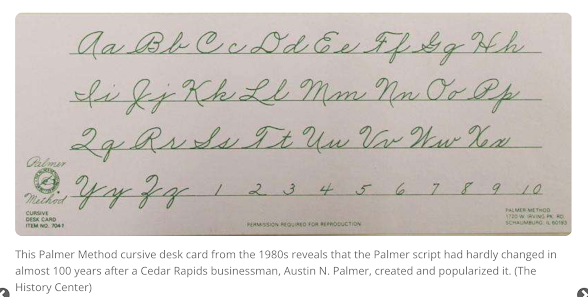Like many millenia-old practices, the invention of cursive writing was more of a collective effort than something we can attribute to one person. It goes as far back as the Roman Empire, after written language first developed. Square capitals were used on inscriptions or buildings and monuments (some of which are still standing), but cursive (or script) was used for daily writing.
Later, in the eighth century, monks created the Carolingian script — the earliest form of standardized cursive that others built upon. This script evolved during medieval times, and its twists and curls became harder to read before the Renaissance revived the Carolingian way. The earliest form of cursive you probably recognize is called Copperplate. Calligrapher Timothy Matlack penned Thomas Jefferson’s words on the original copy of the Declaration of Independence using the Copperplate script.
While beautiful, this fancy calligraphy wasn’t practical for everyday writing, so a teacher named Platt Rogers Spencer developed a new form of penmanship around the mid-1800s. He came up with the name “chirythmography,” from the Greek words for “timed handwriting.” He used a metronome for writers to keep pace with his elliptical letters, which he claimed were inspired by nature. The “Spencerian” method was taught in schools for the latter half of the 19th century.
Quick-working clerks and telegraph operators translating Morse code into script found the Spencer cursive still too time consuming, though. Enter: Austin Palmer and the Palmer Method. Palmer’s idea was to make cursive writing more practical and lose the fancy flourishes from the Renaissance days. This form of script was very popular in the early 20th century and can probably be seen in old letters from your great- and great-great-grandparents.
From there, penmanship started to become big business. It was taught in grade schools, and adults entering the business world got a leg up if they completed a course in a penmanship school. The Zanerian College of Penmanship became the Zaner-Bloser Company, selling handwriting instruction material to schools. (Fun fact: Zaner-Bloser, Inc., still publishes Highlights for Children magazine.) The Zaner-Bloser cursive and the later D’Nealian cursive are the simple scripts that were taught in grade school during the second half of the 20th century. While many school districts dropped cursive curriculum in the 2010s, it recently began regaining a foothold across the United States. In 2024, California became the 22nd state to require teaching cursive handwriting in its schools.
----------------------------------------------------------------------------------------------
P1 (7)
Like many millenia-old practices, the invention of cursive writing was a collective effort.
Its invention is not something that can be attributed to one person.
Cursive writing goes as far back as the Roman Empire in the 5th century.
It appeared after written language first developed.
Cursive, also known as script, was used for daily writing.
At the same time, square capitals were used on inscriptions or buildings and monuments.
Some of these still standing.
P2 (11)
Later, in the eighth century, monks created the Carolingian script.
This is the earliest form of standardized cursive upon which the others are built.
This Carolingian Script ↓ evolved during medieval times.
The earliest form of cursive familiar to most people is called Copperplate.
Calligrapher Timothy Matlack penned Thomas Jefferson’s words on the original copy of the Declaration of Independence using the Copperplate script. ↓
Although beautiful, this fancy calligraphy wasn’t practical for everyday writing.
A teacher named Platt Rogers Spencer developed a new form of penmanship around the mid-1800s.
He came up with the name “chirythmography,” from the Greek words for “timed handwriting.”
He used a metronome for writers to keep pace with his elliptical letters.
Spencer felt the script was inspired by nature.
This “Spencerian” ↓ method was taught in schools for the latter half of the 19th century.
P3 (19)
Cursive is a faster form of writing than printing and was used by clerks and telegraph operators.
Telegraph operators translated Morse code into script,
Quick-working clerks and telegraph operators found the Spencer cursive still too time consuming.
Enter: Austin Palmer and the Palmer method!
Palmer’s idea was to make cursive writing more practical.
The first step was to lose the fancy flourishes from the Renaissance days.
The Palmer method script was very popular in the early 20th century.
It can probably be seen in old letters from your great- and great-great-grandparents.
Penmanship started to become big business.
It was taught in grade schools.
Adults entering the business world were more esteemed if they completed a course in a penmanship school.
The Zanerian College of Penmanship, which later became the Zaner-Bloser Company, sold handwriting instruction material to schools.
The company was very successful.
Fun fact: Zaner-Bloser, Inc., still publishes Highlights for Children magazine.
The Zaner-Bloser cursive, one of the simple scripts, was taught in grade school during the second half of the 20th century. ↓
The other simple cursive script taught in schools at that time was D’Nealian cursive.
Many school districts dropped cursive curriculum in the 2010s.
Recently has begun regaining a foothold across the United States.
In 2024, California became the 22nd state to require teaching cursive handwriting in its schools.
https://wordsmarts.com/history-cursive-writing/





